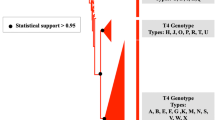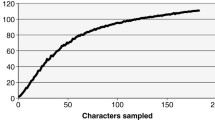Abstract
This study was carried out to document the genotypes of Acanthamoeba present in contact lens cases from 50 randomly selected contact lens wearers living in Quezon City, Metro Manila, Philippines. Acanthamoeba species were isolated from eight (16%) in 50 contact lens cases examined. We analyzed partial 18S ribosomal DNA (Rns) sequences of the eight isolates and found that the sequence differences were sufficient to distinguish the genotypes. After the isolates were genotyped, using the Basic Local Alignment Search Tool program, their phylogenetic positions relative to known Acanthamoeba isolates were determined. The model-based (GTR+Γ+Ι) neighbor-joining, maximum likelihood, and Bayesian inference analyses, as well as the non-model-based maximum parsimony analysis were used. Results showed that of the eight isolates, six were Rns genotype T5 while two were Rns genotype T4. This present study indicates that genotype T5 is also a common contaminant in contact lens storage cases.

Similar content being viewed by others
References
Barete S, Combes A, de Jonckheere JF, Datry A, Varnous S, Martinez V, Ptacek SG, Caumes E, Capron F, Frances C, Gibert C, Chasidow O (2007) Fatal disseminated Acanthamoeba lenticulata infection in a heart transplant patient. Emerg Infect Dis 13:736–738
Booton GC, Kelly DJ, Chu Y-W, Seal DV, Houang E, Lam DSC, Byers TJ, Fuerst PA (2002) 18S ribosomal DNA typing and tracking of Acanthamoeba species isolates from corneal scrape specimens, contact lenses, lens cases, and home water supplies of Acanthamoeba keratitis patients in Hong Kong. J Clin Microbiol 40:1621–1625
Booton GC, Rogerson A, Bonilla TD, Seal DV, Kelly DJ, Beattie TK, Tomlinson A, Lares-Villa F, Fuerst PA, Byers TJ (2004) Molecular and physiological evaluation of subtropical environmental isolates of Acanthamoeba spp., causal agent of Acanthamoeba keratitis. J Eukaryot Microbiol 51:192–200
Booton GC, Visvesvara GS, Byers TJ, Kelly DJ, Fuerst PA (2005) Identification and distribution of Acanthamoeba species genotypes associated with nonkeratitis infections. J Clin Microbiol 43:1689–1693
Gast RJ (2001) Development of an Acanthamoeba-specific reverse dot-blot and the discovery of a new ribotype. J Eukaryot Microbiol 48:609–615
Gast RJ, Ledee DR, Fuerst PA, Byers TJ (1996) Subgenus systematics of Acanthamoeba: four nuclear 18S rDNA sequence types. J Eukaryot Microbiol 43:498–504
Guindon S, Lethiec F, Duroux P, Gascuel O (2005) PHYML online—a web server for maximum likelihood-based phylogenetic inference. Nucl Acids Res 33:W557–W559
Hammersmith KM (2006) Diagnosis and management of Acanthamoeba keratitis. Curr Opin Ophthalmol 17:327–331
Hewett MK, Robinson BS, Monis PT, Saint CP (2003) Identification of a new Acanthamoeba 18S rRNA gene sequence type, corresponding to the species Acanthamoeba jacobsi Sawyer, Nerad and Visvesvara, 1992 (Lobosea: Acanthamoebidae). Acta Protozool 42:325–329
Jeong HJ, Yu HS (2005) The role of domestic tap water in Acanthamoeba contamination in contact lens storage cases in Korea. Korean J Parasitol 43:47–50
Jeong HJ, Lee SJ, Kim JH, Xuan YH, Lee KH, Park SK, Choi SH, Chung DI, Kong HH, Ock MS, Yu HS (2007) Acanthamoeba: keratopathogenicity of isolates from domestic tap water in Korea. Exp Parasitol 117:357–367
Joslin CE, Tu EY, Shoff ME, Booton GC, Fuerst PA, McMahon TT, Anderson RJ, Dworkin MS, Sugar J, Davis FG, Stayner LT (2007) The association of contact lens solution use and Acanthamoeba keratitis. Am J Opthalmol 144:169–180
Kaji Y, Hu B, Kawana K, Oshika T (2005) Swimming with soft contact lenses: danger of Acanthamoeba keratitis. Lancet Infect Dis 5:392
Kilvington S, Gray T, Dart J, Morlet N, Beeching JR, Frazer DG, Matheson M (2004) Acanthamoeba keratitis: the role of domestic tap water contamination in the United Kingdom. Invest Ophthalmol Vis Sci 45:165–169
Köhsler M, Leitner B, Blaschitz M, Michel R, Aspöck H, Walochnik J (2006) ITS1 sequence variabilities correlate with 18S rDNA sequence types in the genus Acanthamoeba (Protozoa: Amoebozoa). Parasitol Res 98:86–93
Lee SM, Choi YJ, Ryu HW, Kong HH, Chung DI (1997) Species identification and molecular characterization of Acanthamoeba isolated from contact lens paraphernalia. Korean J Opthalmol 11:39–50
Lorenzo-Morales J, Ortega-Rivas A, Martinez E, Khoubbane M, Artigas P, Periago MV, Foronda P, Abreu-Acosta N, Valladares B, Mas-Coma S (2006) Acanthamoeba isolates belonging to T1, T2, T3, T4, and T7 genotypes from environmental freshwater samples in the Nile Delta Region, Egypt. Acta Trop 100:63–69
Marciano-Cabral F, Cabral G (2003) Acanthamoeba spp. as agents of disease in humans. Clin Microbiol Rev 16:273–307
Niyadurupola N, Illingworth CD (2006) Acanthamoeba keratitis associated with misuse of daily disposable contact lenses. Cont Lens Anterior Eye 29:269–271
Page FC (1988) A new key to freshwater and soil Gymnamoebae with instructions for culture. Freshwater Biological Association, Ambleside
Rivera WL, Adao DEV (2008) Identification of the 18S-ribosomal-DNA genotypes of Acanthamoeba isolates from the Philippines. Ann Trop Med Parasitol 102:671–677
Rivera WL, Tachibana H, Silva-Tahat MRA, Uemura H, Kanbara H (1996) Differentiation of Entamoeba histolytica and E. dispar DNA from cysts present in stool specimens by polymerase chain reaction: its field application in the Philippines. Parasitol Res 82:85–589
Ronquist F, Huelsenbeck JP (2003) MrBayes 3: Bayesian phylogenetic inference under mixed models. Bioinformatics 19:1572–1574
Schroeder JM, Booton GC, Hay J, Niszl IA, Seal DV, Markus MB, Fuerst PA, Byers TJ (2001) Use of subgenic 18S ribosomal DNA PCR and sequencing for genus and genotype identification of acanthamoebae from humans with keratitis and from sewage sludge. J Clin Microbiol 39:1903–1911
Seal DV, Kirkness CM, Bennett HG, Peterson M, Keratitis Study Group (1999) Acanthamoeba keratitis in Scotland: risk factors for contact lens wearers. Cont Lens Anterior Eye 22:58–68
Silvany RE, Dougherty JM, McCulley JP, Wood TS, Bowman RW, Moore MB (1990) The effect of currently available contact lens disinfection systems on Acanthamoeba castellani and Acanthamoeba polyphaga. Ophthalmology 97:286–290
Spanakos G, Tzanetou K, Miltsakakis D, Patsoula E, Malamou-Lada E, Vakalis NC (2006) Genotyping of pathogenic acanthamoebae isolated from clinical samples in Greece—report of a clinical isolate presenting T5 genotype. Parasitol Int 55:147–149
Stothard DR, Schroeder-Diedrich JM, Awwad MH, Gast RJ, Ledee DR, Rodriguez-Zaragoza S, Dean CL, Fuerst PA, Byers TJ (1998) The evolutionary history of the genus Acanthamoeba and the identification of eight new 18S rRNA gene sequence types. J Eukaryot Microbiol 45:45–54
Swofford DL (2000) PAUP*. Phylogenetic analysis using parsimony (*and other methods). V. 4.0b10. Sinauer Associates, Sunderland
Tzanetou K, Miltsakakis D, Droutsas D, Alimisi S, Petropoulou D, Ganteris G, Dolapsaki E, Markomichelakis N, Mallias I, Malamou-Lada E (2006) Acanthamoeba keratitis and contact lens disinfecting solutions. Ophthalmologica 220:238–241
Walochnik J, Obwaller A, Aspöck H (2000) Correlations between morphological, molecular biological, and physiological characteristics in clinical and nonclinical isolates of Acanthamoeba spp. Appl Environ Microbiol 66:4408–4413
Wynter-Allison Z, Morales JL, Calder D, Radlein K, Ortega-Rivas A, Lindo JF (2005) Acanthamoeba infection as a cause of severe keratitis in a soft contact lens wearer in Jamaica. Am J Trop Med Hyg 73:92–94
Yu HS, Choi KH, Kim HK, Kong HH, Chung DI (2001) Genetic analyses of Acanthamoeba isolates from contact lens storage cases of students in Seoul, Korea. Korean J Parasitol 39:161–170
Zhang Y, Sun X, Wang Z, Li R, Luo S, Jin X, Deng S, Chen W (2004) Identification of 18S ribosomal DNA genotype of Acanthamoeba from patients with keratitis in North China. Invest Ophthalmol Vis Sci 45:1904–1907
Acknowledgment
This work was supported financially by a grant from the Japan Student Services Organization (JASSO) to W.L.R. The experiments conducted in this study comply with the current laws of the Philippines.
Author information
Authors and Affiliations
Corresponding author
Rights and permissions
About this article
Cite this article
Rivera, W.L., Adao, D.E.V. 18S ribosomal DNA genotypes of Acanthamoeba species isolated from contact lens cases in the Philippines. Parasitol Res 105, 1119–1124 (2009). https://doi.org/10.1007/s00436-009-1531-9
Received:
Accepted:
Published:
Issue Date:
DOI: https://doi.org/10.1007/s00436-009-1531-9




